Introduction
Enterprise architecture (EA) serves as a pivotal framework that aligns IT infrastructure with business goals, ensuring a cohesive and efficient operation. By providing a comprehensive view of the organization’s processes, information flow, and technology, EA enables streamlined operations and strategic agility. This alignment enhances decision-making and resource allocation, driving organizational success.
For instance, the State of Alaska transformed its IT infrastructure to improve data transparency and collaboration across its departments. The state's legacy systems were complex, inefficient, and costly, posing significant risks. By adopting a unified architecture, Alaska enhanced access to digital services and introduced innovative capabilities to meet the expectations of its residents.
Similarly, a government agency managing a fleet of vehicles for federal entities faced challenges with a fragmented system of 19 legacy applications. Each application ran on different programming languages and infrastructures, complicating data management. The agency's transition to a centralized enterprise architecture streamlined operations and improved overall system efficiency.
The exponential growth of data further underscores the importance of EA. Managing diverse data sources and ensuring data quality are crucial for effective decision-making. According to Hrishikesh Joshi of Okta, designing scalable and secure systems is essential for meeting organizational needs and adapting to emerging technologies.
In summary, enterprise architecture not only aligns technology with business objectives but also addresses the complexities of data management and system integration, paving the way for enhanced operational efficiency and strategic growth.
The Importance of Enterprise Architecture in Organizational Success
Enterprise architecture (EA) serves as a pivotal framework that aligns IT infrastructure with business goals, ensuring a cohesive and efficient operation. By providing a comprehensive view of the organization’s processes, information flow, and technology, EA enables streamlined operations and strategic agility. This alignment enhances decision-making and resource allocation, driving organizational success.
For instance, the State of Alaska transformed its IT infrastructure to enhance information transparency and collaboration across its departments. The state's legacy systems were complex, inefficient, and costly, posing significant risks. By adopting a cohesive structure, Alaska enhanced access to digital services and introduced innovative capabilities to meet the expectations of its residents.
Similarly, a government agency managing a fleet of vehicles for federal entities faced challenges with a fragmented system of 19 legacy applications. Each application operated on various programming languages and infrastructures, complicating information management. The agency's transition to a centralized enterprise architecture streamlined operations and improved overall system efficiency.
The exponential growth of information further underscores the importance of EA. Handling varied information sources and ensuring quality are vital for effective decision-making. According to Hrishikesh Joshi of Okta, designing scalable and secure systems is essential for meeting organizational needs and adapting to emerging technologies.
In summary, organizational structure not only aligns technology with business goals but also tackles the intricacies of information management and system integration, paving the way for improved operational efficiency and strategic growth.
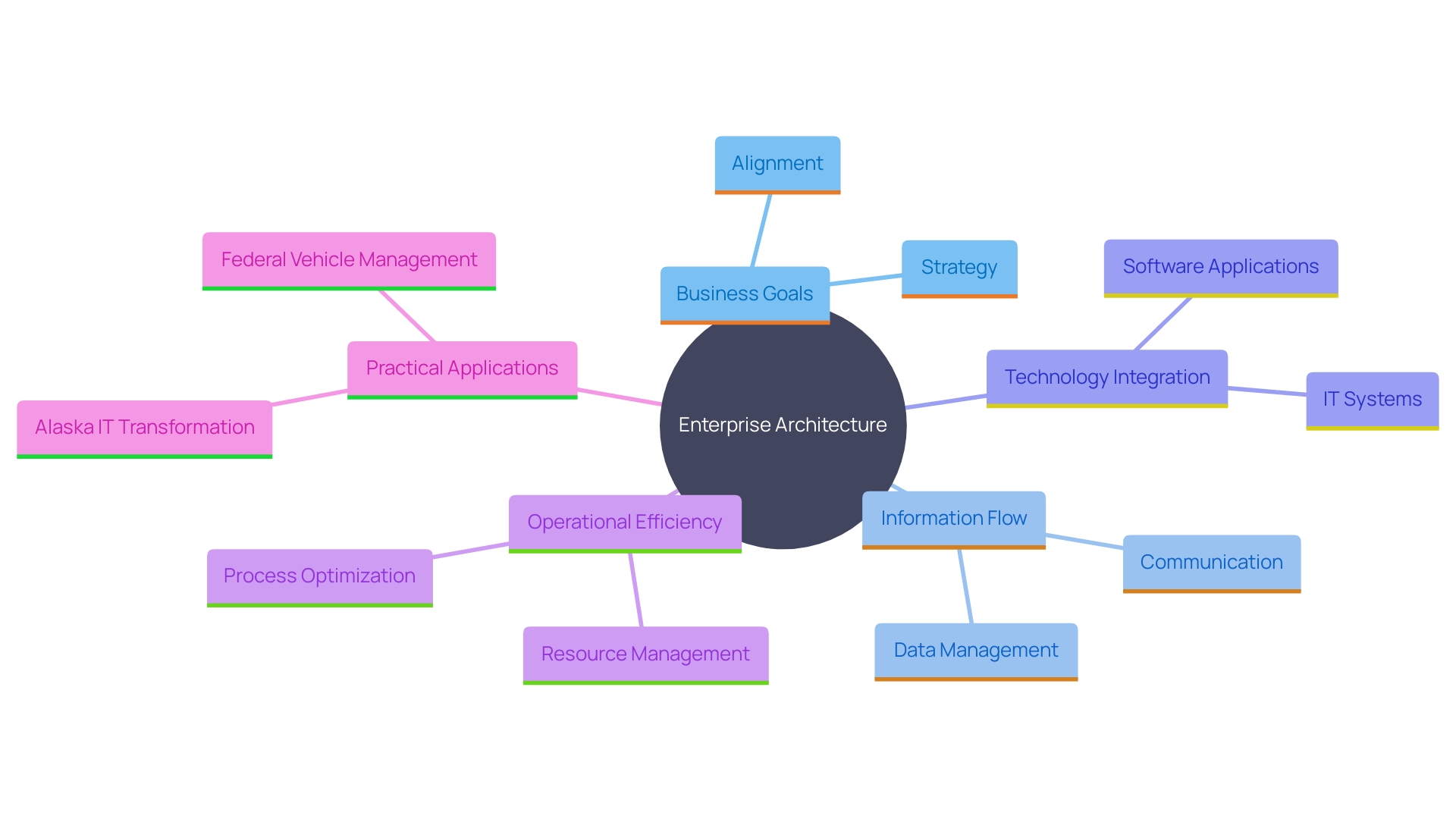
Key Benefits of Enterprise Architecture
Implementing enterprise architecture (EA) brings significant advantages to a business. It enhances operational efficiency by identifying redundancies and optimizing workflows, as seen in the case of a government agency that managed a complex system of 19 legacy applications. By centralizing their data and streamlining their applications, the agency improved their vehicle management services, reducing costs and enhancing reliability.
EA also promotes innovation by allowing entities to adapt swiftly to market changes, thereby preserving competitiveness. As Hrishikesh Joshi from Okta emphasizes, standardized elements in organizational design enable adaptable and swift innovation in reaction to changing market needs.
Furthermore, EA supports risk management by providing a clear understanding of dependencies within the IT landscape. This proactive approach is crucial for identifying potential issues before they escalate. As Gurmat Bhatia emphasizes, key features such as security, reliability, scalability, and maintainability are essential for a robust technology assessment, ensuring that the entity can mitigate risks effectively.
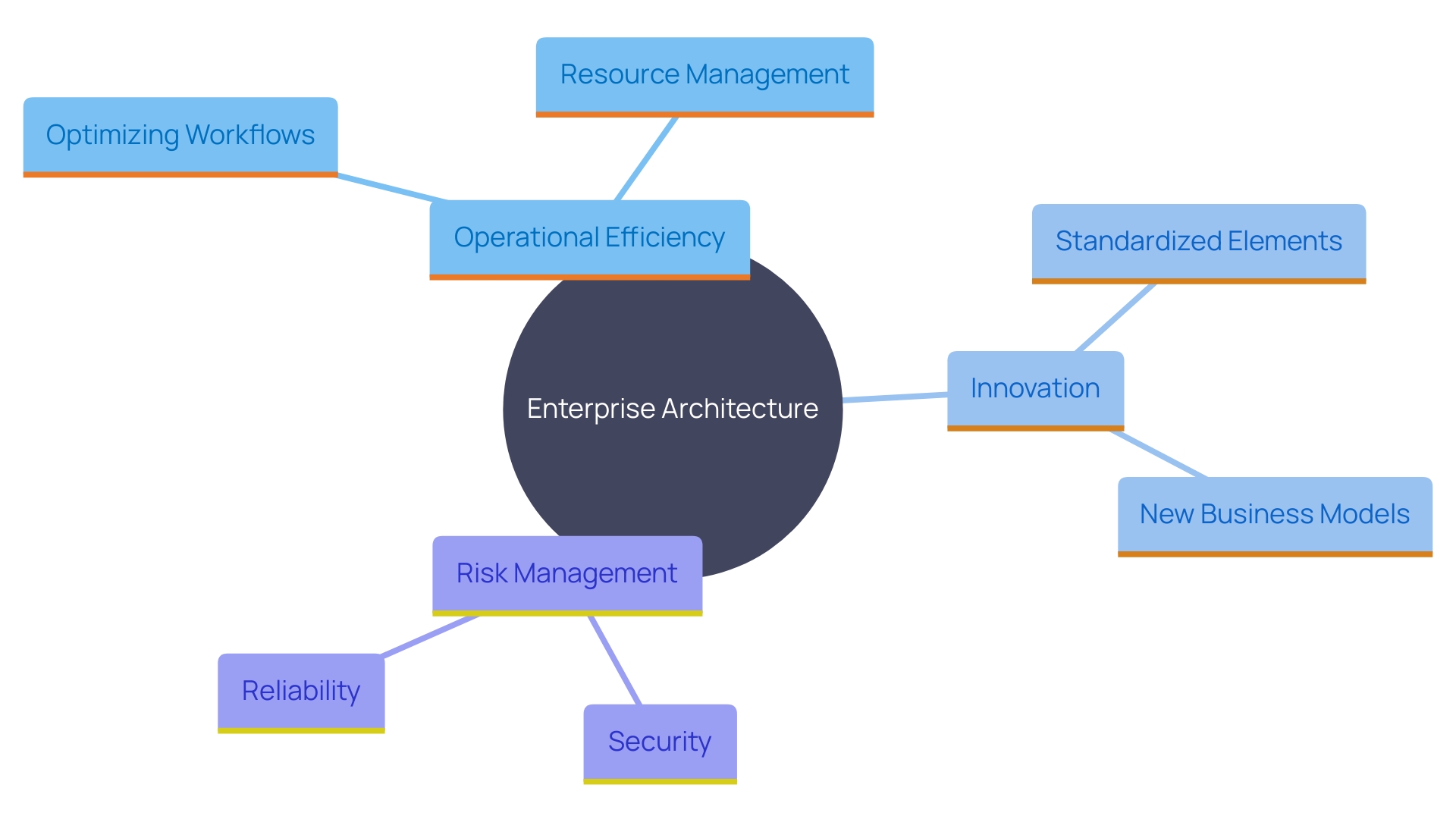
Aligning Business Strategy with Enterprise Architecture
To ensure the effectiveness of enterprise architecture, it is imperative to align it closely with the overall business strategy. This alignment guarantees that IT initiatives support the entity's objectives, fostering enhanced stakeholder engagement and buy-in. As highlighted by Jeanne W. Ross, Peter Weill, and David C. Robertson in their book “Enterprise Architecture as Strategy,” creating a core diagram through collaboration with key stakeholders is essential. This diagram should map out how the business operates, focusing on the most critical components and services.
For instance, Okta's technology leader Hrishikesh Joshi emphasizes the importance of secure and scalable systems that align with business needs. This shared vision between IT and business leaders is crucial for prioritizing projects that deliver maximum value. Enterprise architects must keep the product and customer relationship at the forefront, ensuring that the delivery process meets customer expectations and enhances the product itself.
Furthermore, organizations should adopt a technology roadmap to anticipate future technology needs and align their IT strategies accordingly. This comprehensive approach enables businesses to stay ahead of technological trends and maintain a competitive edge. By integrating these strategies, organizations can achieve a harmonious relationship between business goals and technological advancements, ultimately driving innovation and success.
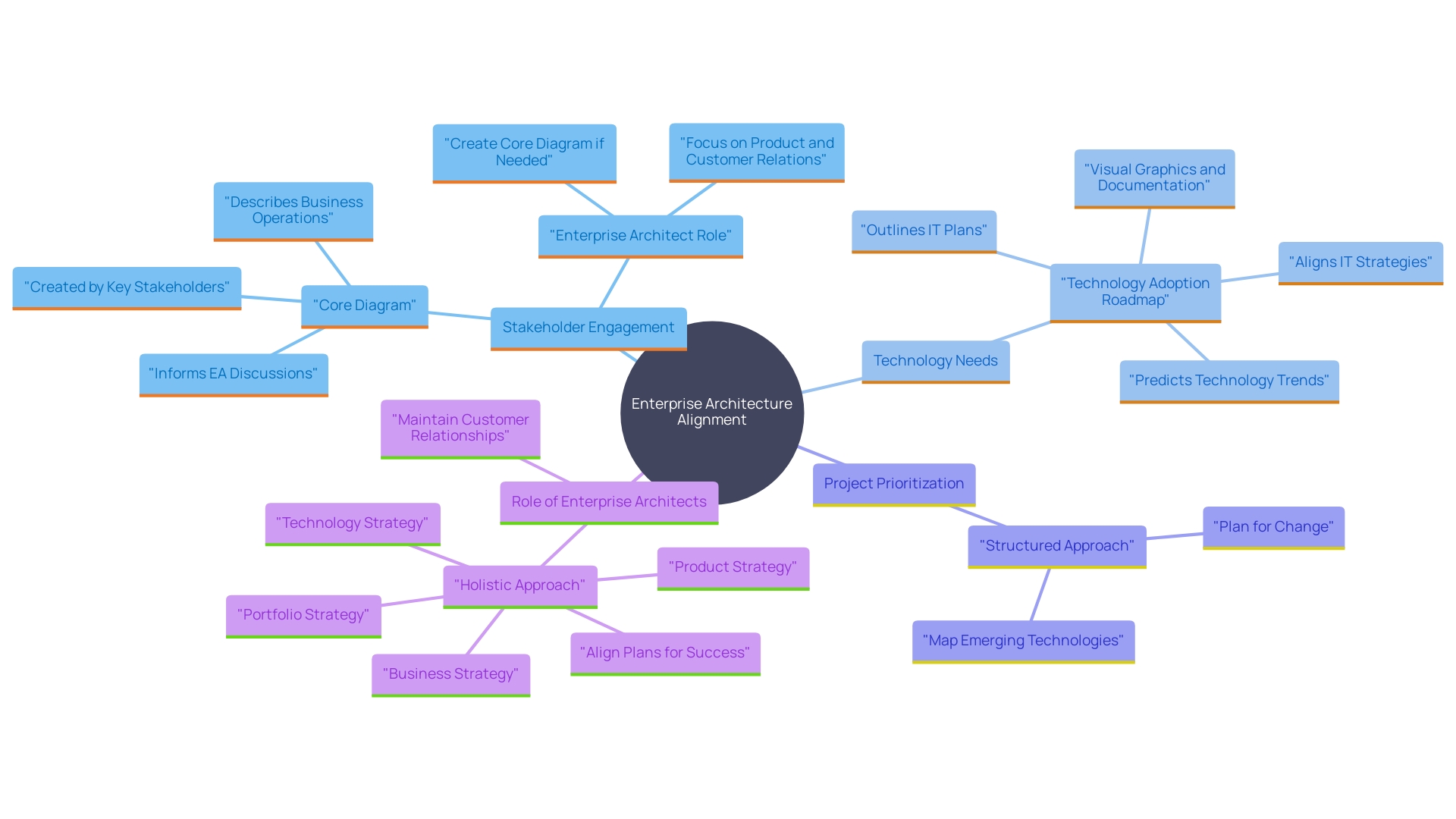
Creating a Comprehensive Enterprise Architecture Framework
A strong organizational framework is anchored by several essential elements, including principles, models, and standards that guide the seamless integration of technology and business processes. Developing this framework necessitates a comprehensive analysis of current capabilities and future needs. As noted in “Enterprise Architecture as Strategy” by Jeanne W. Ross, Peter Weill, and David C. Robertson, a core diagram, created in collaboration with key stakeholders, is essential. This diagram illustrates how the business operates, highlighting vital components and services. It is paramount to prioritize understanding the product and customer relationship over internal mechanisms.
Historical evidence underscores the importance of innovation in maintaining market position. Companies that failed to evolve their products often lost their competitive edge. Consequently, organizational architects must initially concentrate on outlining the product and imagining its future condition, along with guaranteeing efficient delivery systems. This proactive method enables entities to create a versatile framework that can adjust to evolving business needs, ultimately converting data into useful information and promoting effective decision-making.
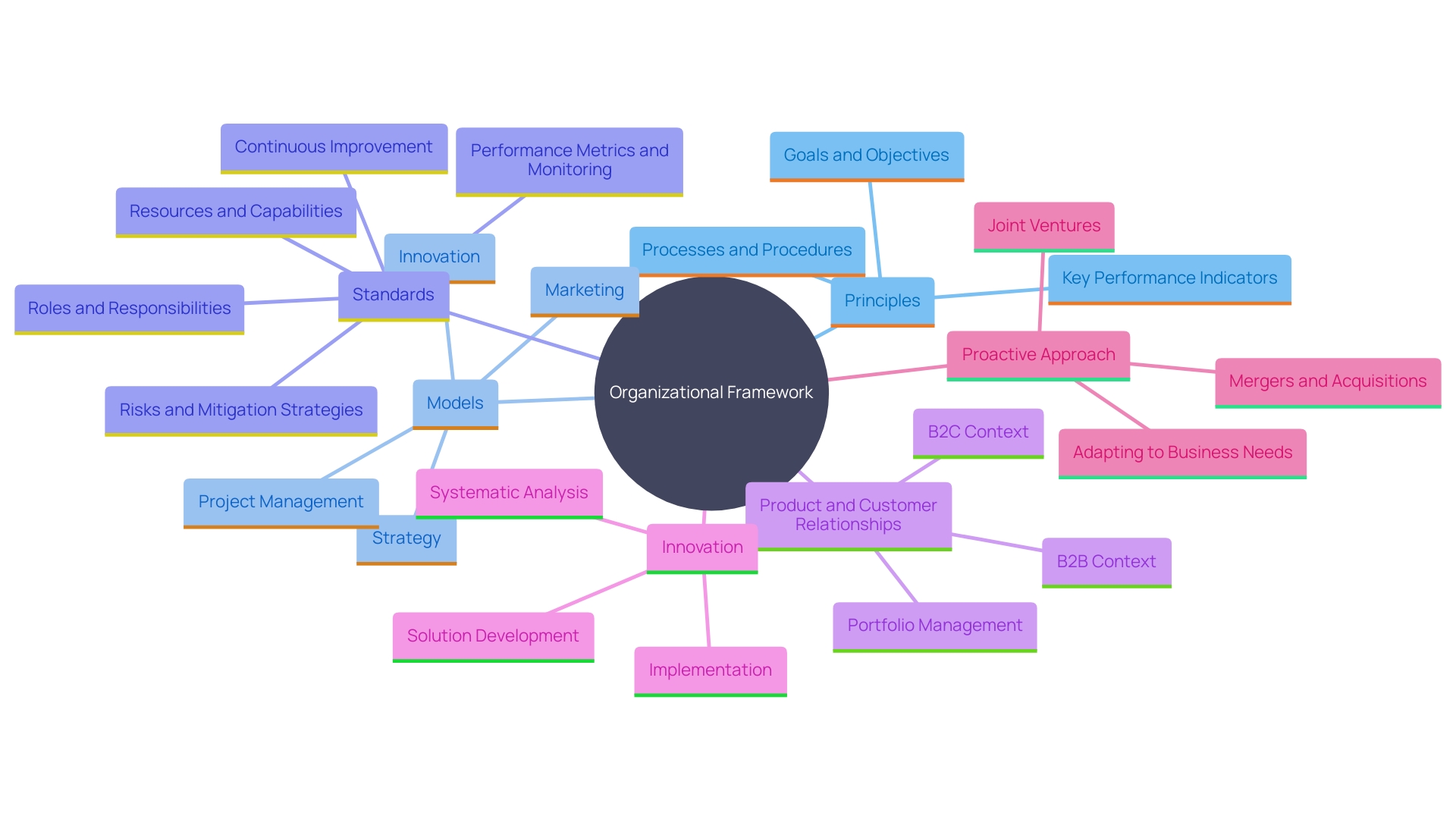
Implementing Enterprise Architecture Governance
Governance plays a crucial role in the effective execution of organizational structure. Establishing well-defined roles and responsibilities is essential to ensure accountability and foster a culture of compliance. A robust governance framework mandates regular reviews and updates to the structure, enabling organizations to swiftly respond to new opportunities and challenges while maintaining alignment with strategic goals.
Developing a thorough governance framework necessitates grasping the complexities of information management, organizational architecture, and strategic initiatives. According to the book “Enterprise Architecture as Strategy” by Jeanne W. Ross, Peter Weill, and David C. Robertson, a core diagram should be developed in cooperation with all key stakeholders. This diagram delineates how the business operates, highlighting critical components and services, and serves as a foundational reference for all enterprise architecture-related decisions.
Furthermore, the exponential growth of information has made managing diverse sources and ensuring quality increasingly challenging. A governance framework should offer an abstract perspective of information-intensive applications, facilitating the transformation of unprocessed content into valuable insights. This approach is crucial for effective decision-making and operational processes.
In alignment with strategic goals, governance must also consider the varying risk levels associated with internal applications, especially with the integration of AI. The EU’s landmark AI act of 2023 emphasizes the importance of categorizing applications by risk, considering the sensitivity of data handled and user access levels. This ensures that AI applications, whether used by well-trained employees or customers, operate within a secure and compliant framework.
By incorporating these components into a unified governance plan, entities can develop a scalable regulatory structure that supports their business model and target operating framework, ensuring ongoing alignment with their strategic vision.
Challenges and Solutions in Implementing Enterprise Architecture
Introducing enterprise design provides considerable advantages, yet organizations frequently face obstacles like resistance to change, inadequate resources, and a shortage of skilled personnel. Addressing these issues requires a multifaceted approach.
Effective change management strategies are essential for overcoming resistance to change. For example, DNEG, a visual effects and animation company, faced bottlenecks in its asset tracking system due to increasing metadata demands. By adopting Red Hat OpenShift and embracing best-practice architectural techniques, DNEG managed to improve system performance and scalability, thus ensuring smoother transitions and sustained engagement.
Adequate training programs are also crucial. A government agency managing a complex fleet management system had to deal with a patchwork of 19 legacy applications, each built on different programming languages and infrastructures. To tackle this, comprehensive training initiatives were crucial for the personnel to navigate and integrate these disparate systems effectively.
Moreover, the allocation of necessary resources cannot be overlooked. According to the Global State of Business Analysis Report, managing and utilizing information effectively is increasingly challenging due to exponential growth and diversity. Ensuring data quality and addressing the challenges of various data sources require significant investment in data structure, underscoring the need for adequate resource allocation to support these complex transformations.
Future-Proofing with Enterprise Architecture: Integration with Emerging Technologies
To stay competitive, companies must incorporate new technologies like artificial intelligence, machine learning, and cloud computing into their structural design. This integration not only enhances operational capabilities but also positions the entity to leverage new innovations effectively. For instance, Bosch's focus on sustainability through innovative energy solutions highlights how integrating AI and machine learning can drive both operational efficiency and environmental impact. An innovative organizational structure framework should be flexible, enabling the effortless integration of these technologies as they progress.
Based on a recent survey, 56% of entities believe that changes in data infrastructure vendors and AI project scope have a 'high' or 'very high' impact on their operations. This underscores the need for a robust technology adoption roadmap that can predict trends and align IT strategies with future needs. As noted in industry reports, the real challenge lies in balancing rapid adoption with maintaining a delicate equilibrium between existing systems and new technologies. By embracing a socio-technical architecture, organizations can ensure that their enterprise architecture is not only resilient but also capable of evolving with emerging trends.
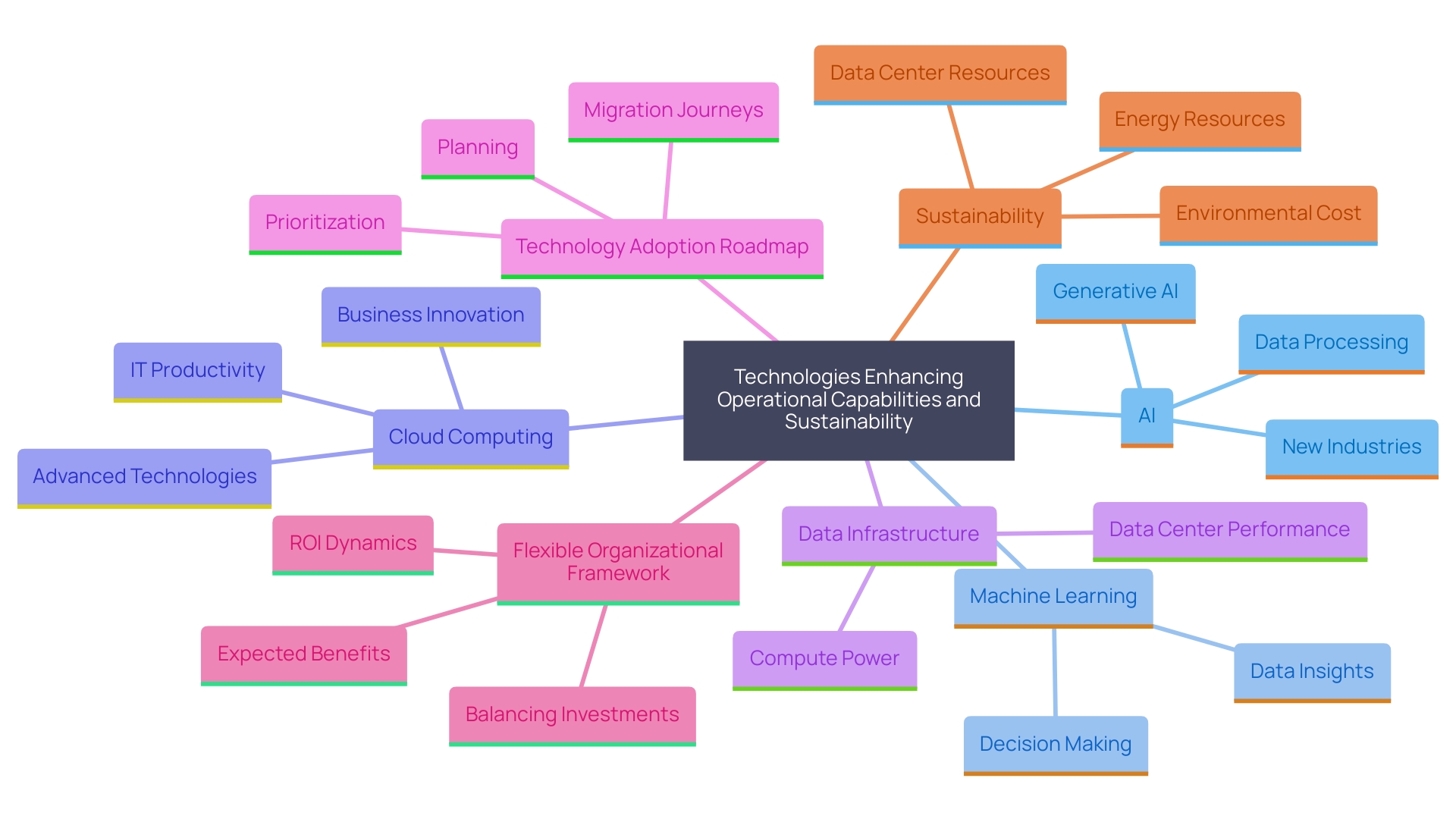
Conclusion
Enterprise architecture (EA) is crucial for aligning IT infrastructure with business objectives, enhancing operational efficiency, and fostering strategic agility. By offering a holistic view of processes and technology, EA facilitates informed decision-making and effective resource allocation. Successful transformations, such as those seen in the State of Alaska and a federal vehicle fleet management agency, demonstrate how centralized architectures can resolve legacy system challenges.
Beyond operational improvements, EA promotes innovation and strengthens risk management. Standardizing components allows organizations to swiftly adapt to market changes, maintaining competitiveness. A clear understanding of IT dependencies enables proactive risk identification and mitigation.
For EA to be effective, it must align closely with overall business strategy, enhancing stakeholder engagement and ensuring IT initiatives deliver maximum value. A technology roadmap is essential for anticipating future needs and keeping IT strategies relevant.
Establishing a robust governance framework is vital for EA success. Clear roles and responsibilities foster accountability and allow organizations to adapt to emerging challenges while maintaining strategic alignment. Addressing data management complexities is increasingly important in today’s data-driven environment.
While challenges such as resistance to change exist, effective change management and adequate training can facilitate successful EA implementation. Integrating emerging technologies further ensures organizations can leverage innovations that enhance operational capabilities.
In summary, enterprise architecture serves as a foundational framework that aligns technology with business goals, addresses data management challenges, and drives innovation. A comprehensive approach to EA positions organizations for sustained success in a rapidly evolving landscape.




